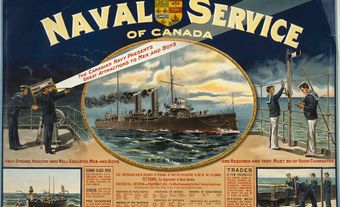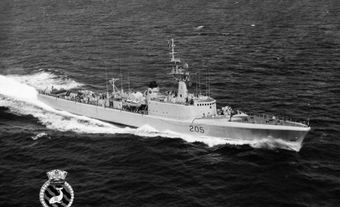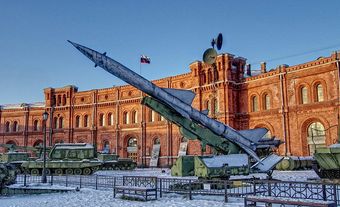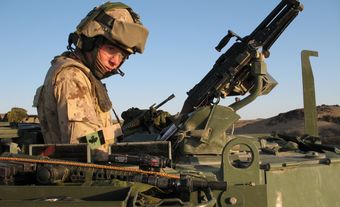The Iroquois class of helicopter-carrying destroyers (DDH) entered service in the Canadian Navy in the early 1970s, featuring several innovations that distinguished them as trailblazers in antisubmarine warfare (ASW). Although only four were built, they played a critical flagship role for deployed Canadian naval task groups. The class was modernized in the early 1990s and transformed into guided-missile destroyers (DDG), providing fleet area air defence until their withdrawal from service in the 2010s.

Design
In December 1964, the Canadian government announced the programme for a class of “Repeat Nipigons,” as a continuation of the successful St Laurent DDH class. The many innovations incorporated during the design process, however, resulted in a much larger and entirely new warship that was nearly twice the size of the St Laurents (at 5,200 tons versus 2,800 tons). The main advances included the switch from steam boiler to all-gas turbine propulsion (the first amongst allied navies, preceded only briefly by the Soviet Navy’s Krivak class) and variable-pitch propellers for rapid change of speed. The new ships also had space for two CH-124 Sea King helicopters (rather than a single one, as on the St-Laurent-class), a ground-breaking computerized command and control system (CCS-280) and powerful new Canadian-designed active sonars (the AN/SQS-505 in both hull-mounted and variable-depth versions). They also carried a heavier 5-inch gun, and the Sea Sparrow point-defence missile system, in a new enclosed stowage configuration to protect it from harsh sub-arctic operating conditions.
Did you know?
As its name suggests, Variable Depth Sonar (VDS) can be deployed at different depths, to overcome difficulties detecting targets in “blind” zones. Oceans typically have a relatively warm surface thermal layer (down to 10-20 metres) that refracts the sound waves projected from hull-mounted sonars. The VDS is an enclosed sonar in an aluminum “body” that is towed behind the ship and lowered below this layer; this allows the ship to search for submarines that otherwise would go undetected “hiding below the layer.”
Around the same time, however, the federal government was trying to cut defence costs. (See also Unification of the Canadian Armed Forces.) Cost overruns nearly led to the programme’s cancellation, and in the end only four were built: Iroquois (280), Huron (281), Athabaskan (282) and Algonquin (283).
Flagship Status
The Iroquois-class destroyers entered service in 1972–73, not long after the decommissioning in 1970 of the aircraft carrier HMCS Bonaventure. This was good timing, as the Iroquois-class could take up that ship’s role as flagship for fleet deployments. Indeed, this capacity allowed Canadian commodores to take command of allied and coalition fleets in such operations as the Persian Gulf War (Athabaskan and Huron, 1990–91); in the Adriatic against the former Republic of Yugoslavia (Algonquin, 1993–94); the post-9/11 war against terror ( Iroquois, Algonquin, and Athabaskan, 2001–03 and 2008); and the Standing Naval Force Atlantic (STANAVFORLANT, all four ships at various times).
Did you know?
When they entered service, the Iroquois-class destroyers were styled “Sisters of the Space Age.” This was the title of a 1974 National Film Board production marking their introduction. Within the navy, they were known more colloquially as the “Tribals” to distinguish them from the older St Laurent “steamer” classes that formed the bulk of the surface fleet.
Update and Modernization
The Iroquois-class was modernized as part of the Mulroney government’s revitalization of the Canadian Armed Forces in the last half of the 1980s. The update complemented the coming introduction of the Halifax-class ASW frigates. Known as the Tribal Update and Modernization Project (TRUMP), the Iroquois-class was converted into guided-missile destroyers (DDG). This involved a major reconstruction of the ships, including replacement of the original gun forward with a 29-cell vertical launch system (VLS) of the SM-2 Block 2 surface-to-air missiles (range approximately 150 km) and a 76mm rapid-firing gun where the Sea Sparrows had been. The distinctive original “bunny ears” funnels were replaced by one large square funnel with a forced-air cooling system; this reduced the thermal infrared signature targeted by enemy missiles. A Phalanx CIWS (close-in weapons system) was installed atop the hangar, and the operations room was totally re-worked to incorporate a new CCS-280 computer system. Algonquin, the first of the class to be updated, was declared operationally ready in March 1993.

Service
For most of the 1970s and 1980s, all four ships were based in Halifax. These were the last two decades of the Cold War and the North Atlantic was considered the primary battleground. A notable exception was the demonstration cruise by Athabaskan and the submarine Ojibwa to the west coast in 1977. (See also Pacific Ocean and Canada.) In the late 1980s, the first Halifax-class frigates were launched, leading to a redistribution of the fleet. Huron and Algonquin were transferred to the west coast in 1987 and 1994, respectively.
Disposal
Huron was mothballed in 2000 due to personnel shortages and to meet defence cutbacks. The ship was sunk in a live-fire exercise by Algonquin on 14 May 2007, an event captured in a History Television documentary, “Sinking a Destroyer.” Further cutbacks meant that necessary repairs were not made to Algonquin and Iroquois, which were taken out of service in the mid-2010s. Athabaskan was the last to be decommissioned, on 10 March 2017. A portion of Iroquois's bow forms the naval monument at the Carling Campus of National Defence Headquarters in Ottawa.


 Share on Facebook
Share on Facebook Share on X
Share on X Share by Email
Share by Email Share on Google Classroom
Share on Google Classroom





